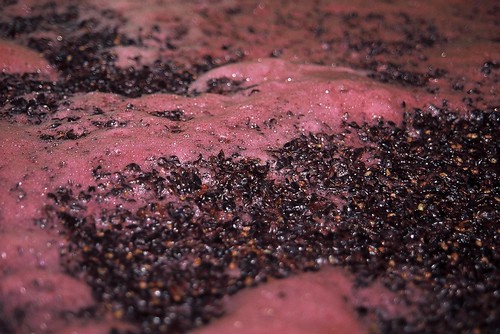
The unfermented must is a vast and plentiful breeding ground for yeast. Food in the form of dissolved oxygen and sugar abounds. For the right strain of yeast this is the perfect place to establish a thriving empire.
The winemaker sets the yeast in motion. They hydrates the yeast, preparing them to conquer this new-found domain. Once the yeast is awakened they are transplanted to this new land.
The Lag Phase
The first order of business is for the newcomers to get the lay of the land. The yeast will acclimate to its new surroundings and environment.
This is called the lag phase because there is not a lot of visible activity. The only evidence that anything is going on is an occasional bubble rising to the surface.
After one to two days, however, our invaders have adapted to their new land and it is time to conquer it!
The Rapid Growth Phase
The yeast is population is still small but because there is plenty of food they begin to multiply at a feverish pace. The population explodes at a logarithmic pace during this phase.
Evidence of their activity can now be seen in the form of vigorous bubbling. They’re now producing carbon dioxide at a staggering rate as a result of consuming their primary food source dissolved oxygen.
Eventually the population reaches a peak. They’ve been producing carbon-dioxide is in such a huge quantity that it begins to saturate their new dominion.
At the same time with the airlock in place on the fermentation tank there is no longer a source of oxygen to replenish what has been consumed. Something must give!
As the population reaches a point where there is no longer enough dissolved oxygen to support new yeast they cease to multiply save to replace fallen yeast on the front line. However, with the booming population they’ve created the yeast eventually runs completely out of food. This marks the end of the rapid growth phase.
The Stationary Phase
Now that the yeast has asserted its dominance over the known lands inside the fermentation tank, the population is maxed out, and the food has run out the yeast must change tactics. Yeast, as it turns out, is a well adapted invader that can do what few other micro-organisms can. They switch to a different food source! At this point they shift from consuming dissolved oxygen to consuming sugar.
Yeast can live in both aerobic environments (with oxygen) and anaerobic environments (without oxygen). Other micro-organisms simply perish once their food source has run out.
While there is plenty of dissolved oxygen the yeast produce mostly carbon dioxide. However, when yeast switches to consuming sugar they not only produce carbon dioxide but alcohol as well!
The Decline Phase
While the yeast is still going strong it is starting to decline for two reasons. On the one hand food is becoming scarce but at the same time their waste product, alcohol, is starting to accumulate to levels too high for them to withstand.
Whether the lack of food or the concentration of alcohol kills of the yeast depends upon the strain of yeast used to ferment the wine. More resilient strains can withstand alcohol content up to 25% and will likely run out of food. A weaker or wild strain of yeast that can only hand alcohol around 10% will likely perish due to an over abundance of alcohol.
Thus one way or another, the yeast empire that flourished during the Rapid Growth Phase tragically falls and the last remaining yeasts die off. They did not die in vain though. Through all their hard work they’ve created one of the most amazing agricultural products known to man, wine.
Photo by: Mark Smith


Hi Mat, I’ve added about a teaspoon of PM To about 12 liters of must. I waited 2 days, then added
fruit wine yeast but fermentation would not start, another 3 days in waiting I added more yeast, still fermentation would not start. How long does it take for the PM to dissipate.
Hi George,
Usually it takes around 24 hours for the potassium metabisulfite to return to levels healthy enough for fermentation to begin. If you think you have too much in there you can give it a good stir and mix in some oxygen. That will help dissipate the suflites more quickly. What are you using for your must? In other words is your wine from fresh fruit, a kit, or grocery store fruit juices or concentrates?
Cheers!
Matt